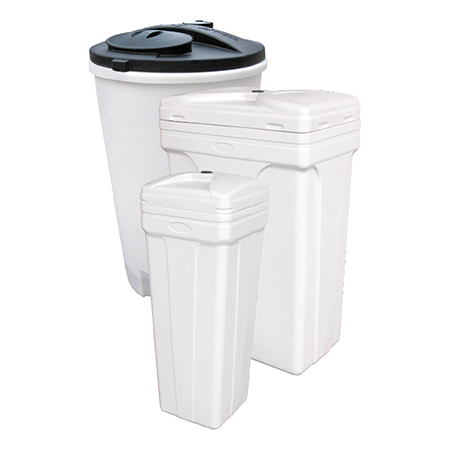
One of the components of the complex water treatment system is such an important unit as the salt tank. Salt tanks come in different shapes and sizes. For each size of the cleaning system, a different size of the salt tank is recommended.
Inside the tank there is a so-called false bottom with perforation. It is supported by snap cups and a pipe (also known as a shaft) with a salt-intake mechanism is attached to one of the inner walls of the tank. This shaft goes along the entire length of the tank from top to bottom, passes the false bottom and goes to the bottom of the tank. This is how almost any salt tank is arranged.
The fake bottom divides the tank into two parts. Under the false bottom do not fall into the salt tablets and there is a ready concentrated brine.
Without the false bottom, the amount of available brine would be less - it's just a few liters of liquid that is distributed in the free space between the tablets. And the smaller the tablets become, the smaller the space and therefore the less brine. If the system's filter tank is small, you can do without a false bottom.
The false bottom contains "untouchable" reserve, allowing the necessary volume of salt to dissolve in the necessary volume of water. The bigger the size of the system, the bigger the size of the used tank and the more space it has under the false bottom.
The second important unit in the salt tank is the salt intake mechanism (salt valve), which is located in the sump inside the tank. It is a special valve that performs two functions:
-
The first one is that when the tank is to be refilled with water by means of a float switch (as in a toilet bowl), it stops the water supply to the tank. The float can be adjusted downwards to determine the amount of water in the tank, depending on the needs of a particular system size. Also, the float will protect against flooding if at the time of refilling the tank the electricity is lost and the control unit valve will stand in the "brine filling" mode.
-
The second one is that during the regeneration process, when the brine is sucked in, the ball valve at the bottom of the unit falls with the brine level dropping and thus stops the air suction into the system casing.
The first time you start up the filter, the water enters the tank. Sometimes you can fill the tank manually. Salt is then filled into the tank. After 2-3 hours the brine is ready for use. But it will not be used immediately. The automatic control unit monitors how much water has passed through the filter and at the end of the resource will assign regeneration of the system. During flushing, the automatic system will switch on the "drinking" mode and thanks to the integrated ejector, salt line from the tank will supply the system with brine. At the end of the rinsing, the control unit itself will fill up the required amount of water for brine preparation the next time.
How do you set the salt tank correctly?
Setting up the salt tank is to set the correct refilling time in the system control unit program and to set the float switch level inside the mine correctly. To do this, we need to know how many litres of filter media are in your system. Normal regeneration of one liter of ion exchange resin requires 120 grams of salt. Accordingly, for example, a system 1054 cylinder with a resin loading rate of 38-40 litres requires 4.5 salt per rinse. The solubility limit for salt in cold, undistilled water is 300 grams per 1 liter of water. Accordingly, in order to dissolve 4.5 kg of salt it is necessary to dissolve 15 litres of water. In the control unit you set the time of water refilling into the tank, sufficient for a set of 15 liters above the false bottom. Then fill the tank with salt until the water level is equal to the salt level. This will be the float switch setting level. Therefore, it is not important that the tank can contain 25-30 kg of salt. If everything is adjusted correctly, no more salt will be used for one regeneration.
|
Product code |
Product |
Price, Euro, |
|
BT-200C |
Salt tank 200 l, complete set |
58,62 |
|
BT-350C |
Salt tank 350 l, complete set |
122,56 |
|
BT-500C |
Salt tank 500 l, complete set |
170,15 |
|
BT-750C |
Salt tank 750 l, complete set |
216,00 |
|
BT-1000C |
Salt tank 1000 l, complete set |
288,00 |


